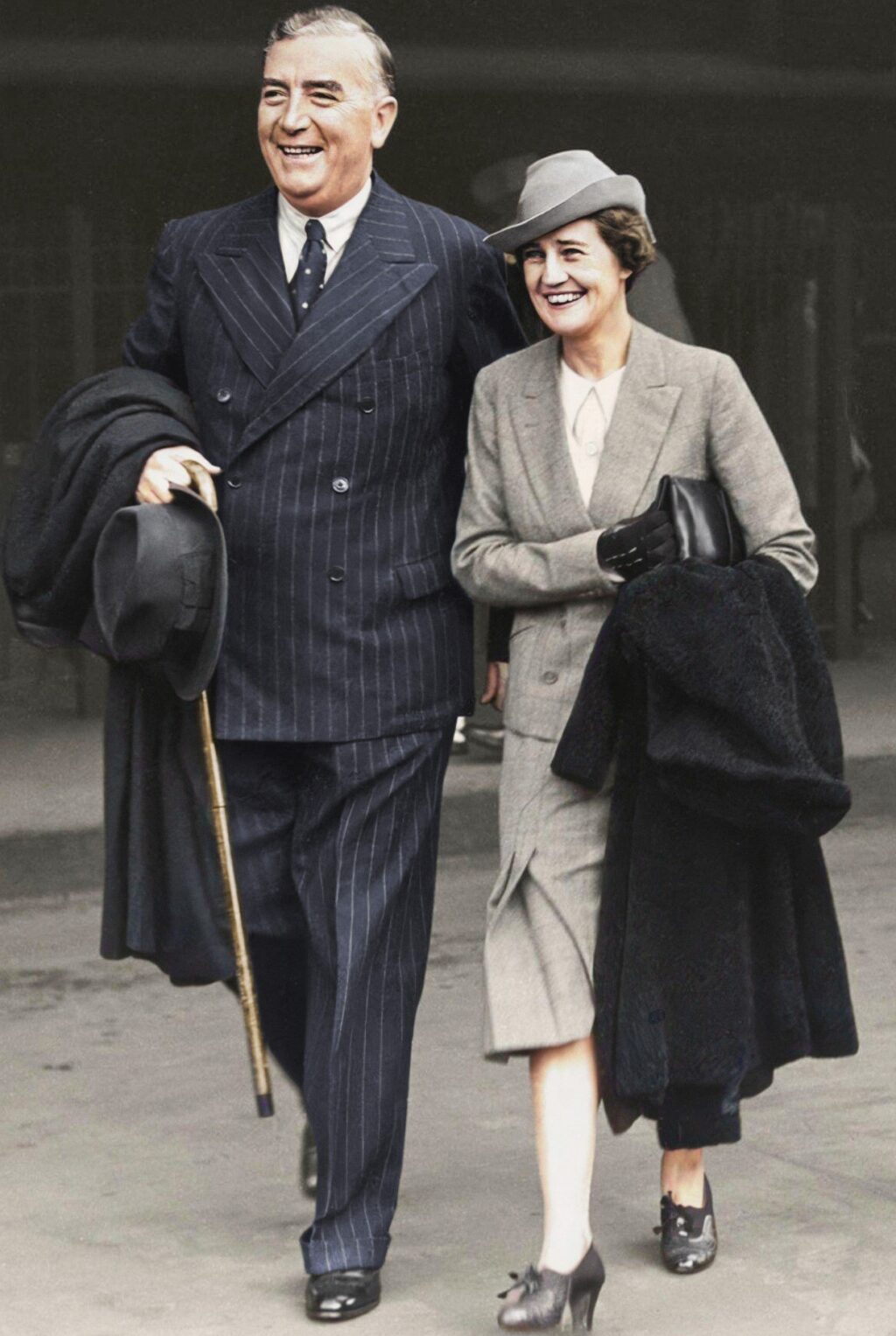On this day, 27 September 1920, Robert Menzies marries Pattie Leckie at the Cotham Rd Presbyterian Church in Kew. Held on a Monday evening at 7.30pm, the ceremony was conducted by Rev. J.R. Anderson.
The wedding received noteworthy newspaper coverage – just a few weeks earlier the 25-year-old groom had won the landmark High Court decision known as the Engineers’ Case, and was consequently a minor celebrity. Menzies later recalled that ‘I got married on the back of’ the courtroom victory. Melbourne’s gossip magazine Table Talk reported on the ceremony:
‘The graceful bride, who was given away by her father, wore a beautiful gown of ivory satin, made with pannier draperies, held with clusters of exquisite hand-made silver flowers, and a softly folded corsage with georgette sleeves. A beautiful veil of old Honiton lace, held by a wreath of silver flowers, fell in graceful folds over the whole, softening the effect in a charming way. A bouquet of white heath, roses, narcissi and orange blossom was the complement.
The bridesmaids, the Misses Coryn and Gwenyth Leckie, sisters of the bride, and Miss Ruth Gosman, were a dainty group in pretty frocks of ivory shadow lace, trimmed with pearls, and head bands of pink and silver, and posies of pink roses. Mr. Frank Menzies (brother of the bridegroom) was best man, and Mr. P. Etterson and Sydney Menzies (brother of bridegroom) were groomsmen.
The reception was held at the Grand Hotel, the guests being received by Mr. and Mrs. Leckie (step-mother of the bride) in the lounge. After the guests had felicitated the bride and bridegroom, they adjourned to the tapestry room, where supper was served. The scheme of decoration in pink roses and sweet pea, with trails and wreaths of orange blossom, was beautiful.
The bride’s travelling costume was navy blue ratine tailor-made suit, with cherry-color silk hat and fox furs.’
Five years younger than her husband, Pattie had been born at Alexandra, in central-eastern Victoria in 1899. Her father John was initially a farmer and storekeeper but would go on to have a career in centre-right politics. He stood as an Anti-Socialist Protectionist trying to oust a sitting Deakinite at the 1906 federal election, before being elected to the Victorian Parliament in 1913. He moved to the Federal Parliament in 1917 as the member for Indi. Losing his seat in 1919, he was elected as Senator for Victoria in 1934 (at the same election in which Menzies entered federal politics) and would go on to serve briefly as Menzies’s Minister for Aircraft Production. Pattie’s mother died when she was only seven, hence she grew particularly close to her father and would frequently accompany him on election tours – giving her a perfect training for her future life with Robert.
Pattie was educated as a boarder at the Presbyterian Ladies’ College, East Melbourne, and then at Fintona, in Camberwell. While there, she routinely sat with her schoolmates in Sunday services at the local Presbyterian churches, and it just so happened that Menzies’s family also attended variously the East Melbourne and Camberwell Presbyterian churches – giving them an acquaintance from an early age. The pair met more formally some years later at a party at Camberwell; the family legend being that Robert walked into the room, strode across to her, and said: ‘You’re Pattie Leckie; you used to make eyes at me in church’.
They would go on to have three surviving children: sons Ken born 1922 and Ian born 1923, and finally a daughter Heather, who came in 1928. Another child was tragically lost at birth – inspiring Pattie to take up charity work for the Royal Children’s and Royal Melbourne hospitals.
Pattie would play a very central role in her husband’s career – a close confidant, she was the one who convinced Menzies to take up Joseph Lyons’s offer to enter federal politics in 1934. Her ADB entry notes:
‘Pattie accompanied her husband on almost all his domestic and overseas tours as well as to local political meetings. She had a humanising effect; one observer called her Menzies’s secret weapon. Menzies maintained that a common reaction was: “she can’t be Bob Menzies’ missus … she’s much too nice”. She also undertook many public commitments in her own right, speaking with a naturalness and humour that engaged her audiences, but she always remained circumspect about political issues. The only interventions she acknowledged were a suggestion about housing for the elderly, which resulted in the Aged Persons’ Homes Act 1954, and a plea for footpaths in Canberra, a city to which she was fiercely loyal. Privately, she continued to offer her husband down-to-earth advice and to serve as a sounding board or, when necessary, a debunker. In 1954 she was appointed GBE. Menzies remarked: “No man ever had a more marvellous co-worker”. Over her husband’s long second term as prime minister, she perfected the self-effacing, supportive role of prime minister’s wife, in the manner expected at the time. On Menzies’s retirement in January 1966, the head of his department, Sir John Bunting, judged her to be “the classic prime minister’s wife”’
Further Reading:
A.W. Martin, Robert Menzies A Life Volume 1
Diane Langmore, ‘Menzies, Dame Pattie Maie (1899–1995)’, Australian Dictionary of Biography, National Centre of Biography, Australian National University, 2019.
Sign up to our newsletter
Sign up for our monthly newsletter to hear the latest news and receive information about upcoming events.


